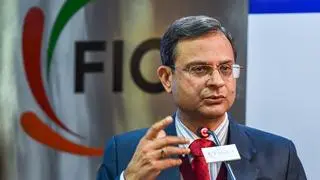The maiden full-year Union Budget of the NDA Government is the most defining Budget in recent years. It adequately balances the need for addressing growth in the short-term and has taken several steps to revitalise the economy in the long-term, while deepening focus on fiscal responsibility and budget management (FRBM) through the medium-term fiscal deficit target of 3 per cent of GDP by 2017-18.
This is a commendable initiative, given the impending fiscal burden from the report of the Seventh Pay Commission and the implementation of GST.
Right economic signalsThis transformational Budget truly has the potential to ‘remake India’ against the backdrop of a dramatic fall in crude oil prices and a low domestic CAD, while providing headroom on both the fiscal and external fronts. With the fiscal arithmetic steeped in reality and pronouncements resonating the right ‘economic signals,’ this year’s Budget will find favour among all economic stakeholders, including global credit rating agencies.
Efficiency and quality of expenditure is set to improve. Departing from the recent trend of plan expenditure curtailment single-handedly compensating for revenue shortfall, in 2014-15, both plan and non-plan expenditure shared this burden (in 1:2 ratio), supported in part by the deregulation of diesel and petroleum subsidies.
To take this further, for 2015-16, the Budget has envisaged improving expenditure efficiency, with capital expenditure expected to rise by 0.5 per cent of GDP.
This has been further supplemented by an enhancement in quality of expenditure by shifting focus from revenue to capital spending. As such, non-plan expenditure estimates for the financial year are estimated at ₹13,12,200 crore. Plan expenditure is estimated to be ₹4,65,277 crore, which is very near to the revised estimate of 2014-15. This improvement in the expenditure mix will be the catalyst for public investments to lead the investment cycle and ‘crowd-in’ private investments. This will not only allow pushing growth ahead but also help in better inflation management by easing supply constraints.
Increasing tax realisationIn revenues, growth momentum will aid tax buoyancy. The finance minister’s focus on taxation as an instrument of social and economic engineering resonates in the statement of the Budget.
Several steps have laid the foundation of an enabling non-adversarial taxation process. The indirect tax measures introduced in the FY16 Budget would result in net revenue gain of ₹15, 068 crore. As growth improves, tax receipts could receive a further fillip.
There is also greater focus on increasing tax realisation, with a proposed reduction of corporate tax from 30 per cent to 25 per cent over the next four years with accompanied rationalisation and removal of tax exemptions and incentives which have been the foundation of several large tax disputes.
This, coupled with a time-bound approach towards disinvestment, as promised, should obviate an over-dependence on dividend receipts as a source of revenues in 2015-16. This in turn should create fiscal space for PSUs, which are a major source of public capital expenditure albeit outside the purview of the Budget, to undertake longer term investment plans in consonance with the Government’s vision to scale up public investment.
Inclusive growth agendaThrough a mix of pro-business and socio-economic policies, the Government has deftly created impulses for a sustainable and an inclusive growth recovery to commence in 2015-16. A clear roadmap for GST, reduced taxes on SEZs, correcting inverted duties and measures to enhance the ease-of-doing business are likely to improve investor interest and facilitate the ‘Make in India’ programme. The prospective application of GAAR from FY2017 will help further improve foreign investor sentiment. The Budget has also introduced innovative reform measures such as the monetisation of gold.
As one of the largest consumers of gold in the world (importing almost 800-1,000 tonnes/annum), the initiative of introducing gold deposit, gold metal loans will provide greater monetary returns. The introduction of sovereign gold bonds further enhances the endeavour to monetise the significant gold deposits.
The Government has also placed greater emphasis on skill development, with the proposed establishment of a National Skills Mission through the skill development and entrepreneurship ministry. The mission will consolidate skill initiatives spread across several ministries allowing for standard procedures and outcomes across 31 sector skill councils.
On the other hand, the devolution of the 42 per cent share of the divisible pool of taxes to the States would help in furthering the true spirit of cooperative federalism.
This unprecedented increase would add an additional ₹5.24 lakh crore to the States with an additional transfer of ₹3.04 lakh crore through grants and transfer plans. These measures should go a long way in enhancing Centre-State cooperation in fostering inclusive development in the country.
And finallySustained and equitable growth has been the primary focus area of the Budget. The Government has successfully walked the fiscal tightrope while announcing several nation-building schemes. The has also taken the much-awaited step of embracing States as equal partners in the road of economic growth. The greater economic empowerment of States will certainly supplement greater job creation, poverty elimination and economic growth.
Across various parameters, I would rate the Budget 9/10.
The writer is President, Assocham, and MD & CEO, YES Bank








Comments
Comments have to be in English, and in full sentences. They cannot be abusive or personal. Please abide by our community guidelines for posting your comments.
We have migrated to a new commenting platform. If you are already a registered user of TheHindu Businessline and logged in, you may continue to engage with our articles. If you do not have an account please register and login to post comments. Users can access their older comments by logging into their accounts on Vuukle.